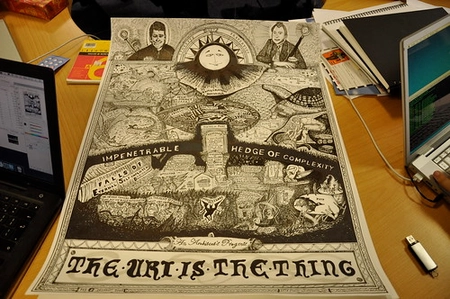At JUXT, we try to reduce the number of tools we use to the bare minimum.
The fewer tools we need to learn to do our work, the more time we can devote to learning each tool well.
Our standard operating system is GNU/Linux (Arch Linux), which we use on both developer laptops and servers. Our standard document format is AsciiDoc (of the Asciidoctor variety). All our documents (contracts, client reports, web pages, blog articles, policy documents, etc.) are stored in AsciiDoc and we generate HTML and/or PDF from these. Adding in git and keybase, we’ve pieced together a capable company document production, approval and management system.
Building document PDFs with make and asciidoctor-pdf
Sometimes, a document might require some custom build logic. For example, a report might contain a table of data extracted from a Crux database. Naturally we use GNU Make and bash to knit together these customised builds, but whenever you try to do something complex, you can end up thrashing around in the long grass.
For example, we have a document named ETH001.adoc which includes an
image stored as ETH001/boy-and-computer.jpg. The PDF version of the
document can be generated using a Make rule:
target/pdf/%.pdf: %.adoc brand/juxt-theme.yml
asciidoctor-pdf -r asciidoctor-diagram -o $@ $<This means that a change to the original Asciidoc source file, or a
change to the theme we use to build the PDFs, will result in the
asciidoctor-pdf executable being run and the resulting PDF rebuilt.
However, since the PDF also contains images, if those images change (sometimes we’re in the process of enhancing images in Gimp), we want the PDF to be rebuilt. But how is it possible to let Make know about these dependencies?
Well, we could go through the source file and look for any image::
tags. Here’s one:
image::ETH001/boy-and-computer.jpg[width=300pt]Then we can add an additional dependency rule inside the Makefile:
target/pdf/ETH001.pdf: ETH001/boy-and-computer.jpgMaintaining these rules might be a pain, and we’ll quickly forget to do
it. My sed and awk skills might be up to the tasks of grep’ing out
the include:: lines of each file, but … I’d much rather be using
Clojure. I’m always struck by the startling contrast between the
consistency and elegance of the Unix line-by-line data processing model
and the inconsistency and ugliness of the syntax of the individual
tools. This is what makes Lisps such as Clojure all the more
extraordinary - an easy-to-learn, consistent syntax which can scale up
to the tackle the most ambitious of problems.
Until now, I probably wouldn’t bother writing a Clojure program for this task. Clojure is a little too slow to start up to be suitable for scripting.
Enter Babashka!
Babashka is a Clojure-like
scripting language written by @borkdude (Michiel Borkent), of
clj-kondo fame. Babashka is close enough
to Clojure so I can avoid having to clutter my memory with the myriad of
different syntaxes of Unix tools (bash, sed, awk, grep). I can leverage
my Clojure familiarity for the boring task of writing scripts.
So let’s write a script (depend_images.clj) that will go through our
50 odd AsciiDoc files, extract out each line that brings in an image,
and print a Make dependency rule between the document and that image:
(doseq
[adoc (.listFiles (java.io.File. "."))
:when (.isFile adoc)
:let [[_ basename] (re-matches #"(.*).adoc" (.getName adoc))]
:when basename
line (line-seq (io/reader adoc))
:let [[_ match] (re-matches #"image::(.*)\[.*\]" line)]
:when match]
(println
(format "target/pdf/%s.pdf: %s" basename match)))In our Makefile we can add a depend target that will run this
script:
depend:
bb depend_images.clj > images.mkWe can run the target with make:
$ make dependOn my machine, that takes about 170ms. That’s perfectly acceptable for my use-case.
The resulting file (images.mk) can be included in the Makefile with
the following:
include images.mkThat’s it.

“Remember, learn Lisp and use it everywhere. Everything else is mind clutter.”
Epilogue
I’m looking forward to reaching for babashka at times where I’d
normally reach for bash (or awk, or sed). Of course, there are
plenty of alternative solutions to these simple problems. However, it’s
a tribute to the design of Clojure that the language feels so naturally
consistent, and can achieve similar feats to a compendium of Unix tools,
each with their own syntactic idiosyncrasies.
For many many years, I’ve wished for a Clojure-like replacement for classic shell-scripting. This may just be it.







